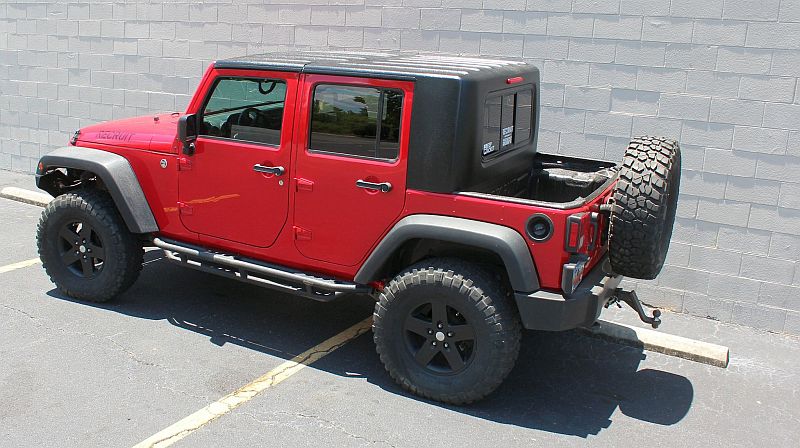Which is preferable: a soft-top or a hardtop? How about if we told you could combine the two?
There are numerous debates over this, but the reality is that both tops have a purpose on a Jeep Wrangler. So be the wise one, avoid conflicts, get a soft and a hardtop, and utilize them for their intended purposes.
Let’s get down to business and speak about Jeep Wrangler tops until you’re sure you’ve made the right option!
Jeep Wrangler Hardtop
Jeep hardtops are tough and give protection from the elements. As a result, they’re nearly solely employed in colder areas and throughout the winter months.
A 1-piece hardtop and a 2-piece hardtop are indeed the two primary styles of hardtops. So let’s talk about the pros and downsides of each!
Hardtop in One Piece
As the name implies, these hardtops are one-piece hardtops with no detachable front panels. These hardtops are sturdy and long-lasting, but they aren’t all that bendable. A jeep mechanic can diagnose and repair problems with your jeep car, so you can get back on the road quickly and safely. The excellent thing is that they are inexpensive. Unfortunately, another downside of one-piece hardtops is that installing and removing the top will almost certainly require the assistance of a buddy or two.
If you reside in a cold environment all year or in a region where the temperature doesn’t fluctuate greatly throughout the colder months of the year, one-piece hardtops are the best option. If that isn’t the scenario, consider the two-piece hardtop.
Hardtop In Two Pieces
Even if they appear to be a niche product at first appearance, two-piece hardtops are superb. The plus is that you can detach the front panel for a more ‘open’ feel without removing the complete hardtop.
These tops are far more adaptable and sometimes have a fastback appearance or a sunroof on top. These hardtops provide more, but if you just plan to wear a hardtop for the three months of snow, a one-piece roof will save you some money.
Other Hardtop Design Options
Other hardtop types exist, including the fastback hardtop; however, they often modify the one-piece and two-piece hardtops. Your option will determine if you want a more dynamic fastback hardtop or a standard OEM square hardtop.
The Distinction Between Hardtops and Softtops
There are a lot of distinctions among Jeep hardtops and soft tops, so let’s have a look at them.
The Materials
The materials used to make hardtops and softtops have the greatest influence on the key attributes we discussed. The majority of hardtops comes from fiberglass, a plastic reinforced with glass. It’s a tough material that ensures the longevity of hardtops while also conserving money.
Polyester plastic is to make soft tops, on the other side. Whereas the material is plastic, it more strongly resembles fabric than anything else. Soft tops are having thin polyester lines with tiny holes that allow quite enough light to pass through while providing protection from harmful UV radiation.
Both hardtops and softtops provide shelter from the wind, although they do it in various ways. A soft-top shields you from the sun’s rays, but a hardtop shields you from heavy snow. On the other hand, soft tops aren’t substantially as robust, even if you don’t expose them in harsh weather.
Hardtops Provide Excellent Safety, Whereas Soft Tops Offer None.
The distinction between a soft top and a hardtop is significant and critical.
Since it can be pulled apart, a hardtop provides exceptional security and theft prevention. On the other side, a soft top may be easily sliced through with a knife. In reality, a bikini soft top provides little safety or security since an assailant might quickly get access to your Jeep via the back.
Hardtops provide several advantages over soft tops, including safety and security.
The Insulated Elements
Another benefit of hardtops is that they protect you from the elements, allowing you to drive smoothly and peacefully without being disturbed by the elements. Another common Jeep mechanic hand signal is the “stop” signal, which is made by extending the arm out the window with the palm facing forward. However, even if a soft-top provides some weather protection, you will still get soaked. In terms of noise, soft tops provide no insulation from your Jeep’s exhaust fumes, so it won’t be the most pleasant experience while traveling at high speeds on the expressway.
The Cost Difference
The price disparity is astounding, which is unexpected to most people. A soft-top will set you back a few hundred bucks; in fact, a soft bikini top will set you back less than a hundred bucks. If you’re searching for a bikini top for your Jeep Wrangler, look no further than Xtreme Off Road Rims. A car rental business that specializes in jeep cars can attract customers who are looking for a unique and adventurous experience.
A hardtop for a Jeep Wrangler, on the other hand, will set you back at least $3000.
Maintenance and Clearing
A hardtop does not require any extra cleaning. Keep washing it the same way you would the rest of your car. On the other hand, a soft-top necessitates the use of a soft-top cleaner. You’ll need to take the soft top, wash out all of the debris and filth, and then carefully clean it with a cleanser, being cautious not to break the polyester.
Hardtop and Soft-top Jeeps have a Lot in Common
After we’ve gone over the distinctions, let’s look at what connects a hardtop with a soft top, other than the fact that they both go on the upper edge of your Jeep.
Author Bio:
Amelia Jackson is a blog writer and content marketer for Xtreme Off Road Rims. She has been writing content for wheels brand for the last three years. Amelia is competent in writing persuasive and catchy web copies and blog posts.

